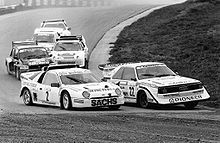Group B
The term group B has been used in motorsport to describe a specific processing stage for Gran Turismo vehicles . They gained enormous popularity when Group B vehicles were used in the World Rally Championship from 1982 to 1986 . At the time, the rules governing automobile sports sovereignty, the FIA, allowed extremely powerful and fast racing cars, which, however, were soon only sufficiently controllable by a few world-class drivers on the rally special stages. After several serious accidents in 1986, these so-called “Group B monsters” were banned from the World Rally Championship.
history
Formation of group B
At the beginning of the 1980s, the FIA changed its regulations, which now only provided for 200 roadworthy vehicles for approval to the new Group B, while a total of 400 vehicles were required for the previous Group 4 homologation. Only 20 cars were required for homologation of so-called evolutionary developments.
The permitted technical changes corresponded to those of group A ; In addition, the rim width, which is not specified in the homologation sheet, but in the generally applicable Section 255 of the ISG , was differentiated according to rallies and other events ; This means events on closed-off routes. For example, a group A car with a rim dimension that did not comply with § 255 was rated in group B (upgrading). A group B car, whose homologation base was closer to motorsport, had better chances than a car in group N or A.

The manufacturers then developed extremely powerful - mostly all-wheel drive - vehicles with up to 500 hp , which even externally showed only a few similarities with the corresponding series vehicles. In the 205, for example, Peugeot turned the front - engined car into a Group B mid-engined car , while Ford and MG in particular presented special models that, due to their appearance, no longer had any relation to the normal sales program of these companies.
Accidents and end of group B
On May 2, 1985 , Attilio Bettega was killed at the Corsica Rally near Zérubia when he went off the road in his Lancia 037 and hit a tree; his co-driver Maurizio Perissinot survived without serious injuries.
On March 5, 1986 , the Portuguese driver Joaquím Santos slid into the uncontrolled crowd of spectators at the Sintra section of the Rally Portugal - as was customary at the events at the time - after he had to avoid a group of spectators on the road. Three people were killed and 31 seriously injured in this accident. All professional teams, including Walter Röhrl (in the Audi Sport quattro S1 ) and his works team Audi Sport , then dropped out of the Portugal rally. The main points of criticism were safety deficiencies such as the inadequate line closures.
The Swiss Formula 1 driver Marc Surer also had a serious accident with a Ford RS200 when his co-driver Michel Wyder was killed by a side impact on a tree at the Hessen Rallye of the same year in Germany.
The next fatal accident followed on May 2, 1986, again at the Corsica Rally , and exactly one year after the fatal accident of Attilio Bettega. The Finn Henri Toivonen came off the track with his Lancia Delta S4 and crashed into a tree below the road. The car burned almost completely due to the explosion of the petrol tanks. Toivonen and his American co-driver Sergio Cresto were unable to free themselves from the inferno.
Peugeot, Lancia and MG drove the 1986 season to an end, after which Group B was banned from the World Rally Championship, while it was used in the European Rallycross Championship between 1987 and 1992 for a further six years. If the FIA had previously well-developed plans to replace Group B in the World Rally Championship from 1988 onwards by an even more liberal Group S , for which only ten homologated cars would have been required, this project, too, was finally stopped. Audi, Lancia, Opel and a few other manufacturers had already developed prototypes for this, which, however, were denied the planned use on the rally slopes of the world.
Group B cars from the 1985 and 1986 World Rally Championships
Renault 5 Maxi Turbo
Toyota Celica TCT
Group B vehicles
- Alfa Romeo Alfasud Sprint 6C
- Audi Sport quattro S1
- BMW M1
- Citroën BX 4TC
- Citroën Visa 1000 Pistes
- Ferrari 288 GTO Evoluzione
- Ford Escort RS1700T
- Ford RS200
- Lada 2105 VFTS
- Lancia 037 Rally
- Lancia Delta S4
- MG Metro 6R4
- Mitsubishi Starion 4WD
- Mazda RX-7 4x4
- Nissan 240RS
- Opel Manta 400
- Opel Manta 200
- Peugeot 205 Turbo 16
- Peugeot 305 V6
- Porsche 911 SC RS
- Porsche 959
- Renault 5 Turbo
- Škoda 130 LR
- Toyota Celica Twin-Cam Turbo
- Wartburg 353 WR
driver
literature
- John Davenport, Reinhard Klein: Group B. The rise and fall of the rally monsters. Klein, Cologne 2007, ISBN 978-3-927458-32-1 .
Web links
- Low-flying aircraft on four wheels on spiegel.de
Individual evidence
- ↑ FIA Regulations, Appendix J 1986, Art. 256 - Specific regulations for Sports Cars (Gr. B): http://www.fia.com/resources/documents/991499716__Hist_App_J_86_Art_256_a.pdf










